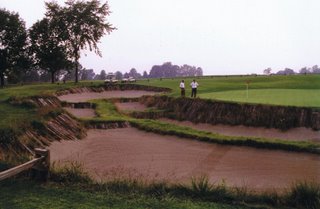5 Modern Courses Worthy of Study
As a follow up to Dave's question, I offer my five modern courses.
The Golf Club is very understaed except the occasion wild bunker
The opener sums up th course well, understated and brilliant
The Golf Club – Pete Dye - variety
I distinctly remember my visit to The Golf Club, I was expecting the TPC at Sawgrass, and was very surprised at how understated the golf course was. Everything on the course, except a couple of very bold features, blended into the surrounding so much that it looked “found” rather than created. There were many great lessons beyond the look or the feel. Pete offered up the largest array of bunkering techniques I have ever recognized on one course. Hazards were central, non-existent, used for carry angles, used for deception, used to frame, and used for show. He did it all, and it worked well because he pulled it together with the overall feel of the site. Anyone visiting here will see where the new minimalists draw their inspiration from. For me it proved you don’t have to define or defends everything, variety is far more important.
The 4th, likely the toughest hole on the course
Pacific Dunes – Tom Doak – ignoring standards
There are many things to admire about Pacific Dunes. The setting and views down the coastline are obvious, but that’s just a start. Doak was smart enough to see this as a resort course and resisted the drive for length, instead he opted for a golf course that was beautiful and eminently playable. It took guts not to find 7000 yards or get constrained by standards. His unconventional placement of threes throughout the round is a testament to using what he found, and not forcing something in. He was also smart enough to recognize the golf course would be very exposed to the wind, and so he created lots of width in the course to keep it playable in tough conditions. The use of interior bunkering to place emphasis on driving the ball in a mild wind was a clever way of keeping width and challenge at the same time. This is proved to me that a great course could be built without length and still be very playable for the average player.
The 2nd hole is a transition from the wooded dunes to the potato fields, but you can't tell.
Friar’s Head – Coore and Crenshaw – the contours make the game great
It would be easy to talk about the magnificent routing that incorporates the Potato Farm with the Wooded Dunes, but Coore and Crenshaw bring something even greater to every site. They design in the fun. The main way they do this is with great contours. The ripples and rumples left in the fairway that add crazy stances or challenging lies for the approach. The humps bumps and hollows all left short around the green that ask your best imagination to solve their complex lines. Then finally at the green the use of humps, tiers and rolls to create greens that complicate an approach and are confounding to putt. This all adds up to a course that would change with each and every play. Isn’t that what we all want to achieve?
I’ve already recently profiled my other two choices
Rustic Canyon - Gil Hanse - ground contours 
Monterey Peninsula (Shore) – Stranz - borrowed scenery
Two other courses that I concidered:
World Woods (Pine Barrens) – Tom Fazio
Bandon Dunes – David Kidd
The courses I wish I had seen that seem worthy of the list:
Sand Hills
Kingsbarns
Kingsley Club
The Travel and Leisure Golf Article that Came From These Lists: http://thecaddyshack.blogspot.com/2006/09/travel-leisure-golf-my-article-in.html

4 comments:
Excuse me if you noted in the post - where is The Golf Club of Dye? There's The Golf Club in Tennessee, USA, which I thought was a Dye course, but I doubt that's where you were. Can't tell from the photo.
Tad,
It's in New Albany, which is just outside Columbus Ohio.
Ian
Another to consider ... and well worth the visit ... is Chechessee Creek, Crenshaw and Coores' understated gem just off Hilton Head Island.
I have been lucky enough to play Sandhills. It is more than worth the effort to get there. The setting is so natural that it brings out the amateur architect in all of us.
SWS
Kingsbarns is seriously over-rated, perhaps understandably given its setting, but it suffers in a number of areas. The bunkers feel as if they are there to look good rather than to cause problems. If a bunker, particularly on the fairway, comes into play, they tend to be obviously avoidable, and the alternative strategy rarely carries its own risks. The greens are huge and sloped into sections. I think there is a place for the occasional green like this, but 18 becomes tedious. Personally, I prefer small greens, some sloping, some more subtle, where there is tremendous satisfaction in finding them. But Kingsbarns is a major let-down in two areas. Firstly Mark Parsinen and Kyle Phillips claimed they wanted to emulate St Andrews with the tee-shots. ie A tighter line which results in a tougher approach, and an easier line giving a tougher approach. In this they failed because Kingsbarns' tougher lines do not have the severe punishment of St Andrews, in out-of-bounds or gorse to the right and a pot bunker to the left. Nor does it have the line-of-pin bunkers that ST Andrews has if you take the easier route. Quite simply if you miss your line off the tee it's rarely a problem. Secondly, the place looks artificial. It is to Scottish Links what Neuschwanstein is to mediaeval castles. In fact if Disneyworld wanted a Scottish 'links', this would be their idea of perfection. Tremendous setting, disappointig course
Post a Comment